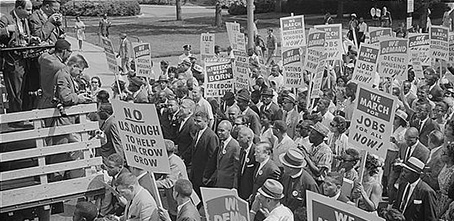- Teacher Resources
- Books & Authors


In 1776, the Continental Congress dissolved their political bands with England, declaring "all men are created equal with certain unalienable rights to life and liberty." Nearly a century later, President Lincoln issued the Emancipation Proclamation, and at the end of the Civil War in 1865, the 13th Amendment to the Constitution prohibited slavery. However, injustices associated with slavery did not end, and four generations later, African Americans were still denied equal access to parks, playgrounds and public schools; and were restricted from the right to vote.
The Civil Rights movement was responsible for the sweeping changes that addressed these injustices, and advanced the equal rights of all American citizens.
In 1896, in Plessy v. Ferguson, the Supreme Court upheld state laws, and ruled that "separate but equal" facilities in the United States were legal.
This institutionalized a segregated school system in the southern states for the different races, and black children were received an inferior education to whites. The 'separate' schools were not providing the 'equal' education declared by the court.
In 1954 a case challenging the "separate but equal" law was brought to the Supreme Court. In Brown v. Board of Education of Topeka, Kansas, the court ruled that segregation in public schools was unconstitutional. Thurgood Marshall argued the case, and the verdict overturned the separation of races in public education.
Although the federal courts had ruled that schools must be integrated, states did not comply with this order. Other injustices included the exclusion of blacks in many public facilities. There were "colored only" and "whites only" bathrooms and drinking fountains; and non-whites were relegated to occupy seats in the back of buses, in the last car of trains, and in movie theater balconies.
In 1955 Rosa Parks refused to give up her seat in the "colored" section of the public bus she was riding. She was arrested, and in solidarity, the African American community refused to ride public buses, sparking the Montgomery, Alabama bus boycott.
Despite the hardships and difficulties in getting to work, the black community stayed united in avoiding the use the Montgomery public buses as they walked, rode in carpools, or took taxis. Finally, after 381 days, on December 20, 1956, the United States Supreme Court ruled that segregation on the buses was illegal, and the boycott ended.
The success of the bus boycott inspired other non-violent protests. People saw that non-violent demonstrations could result in positive changes, particularly in education. The federal government had to send troops protect students trying to desegregate schools in southern states. In 1957 nine black students enrolled in a public high school in Little Rock, Arkansas and President Eisenhower was forced to send federal troops to enforce the court order. In 1960, when Ruby Bridges, a six-year-old first grader integrated a public school in New Orleans, Louisiana, federal marshals were sent to protect the child in response to demonstrations by the white parents. And in 1962, as James Meredith enrolled as the first black student at the University of Mississippi, federal troops were again called in to protect his rights to equal education under the law.
The early1960’s also marked the beginning of other protest movements. Sit-ins were a non-violent method to end segregation of public places. Groups would sit at "white only" lunch counters until blacks had the right to also be served. Other groups organized Freedom Rides to test the desegregation laws. These activities brought further attention to the Civil Rights Movement, and as more people joined the protest movements, organizational groups were formed, including the Congress of Racial Equality (CORE) and the Student Non-Violent Coordinating Committee (SNCC).
In August 1963, Dr. Martin Luther King, Jr. spoke at the March on Washington for Jobs and Freedom. King delivered his famous "I Have a Dream" speech to over 250,000 people. He spoke about his dream of equality for all, and increasingly, more of America was becoming aware of the racial injustices in the country.
During the same time, black citizens of the south were being denied their rights to vote. Black citizens who registered to vote had to take a literacy test and pay a poll tax. These restrictions were part of the Jim Crow laws, which kept black and whites separate and also made it illegal for blacks to use the same public facilities as whites.
President Lyndon Johnson signed the Civil Rights Act into law in 1964. This law prohibits discrimination of all kinds, based on race, color, religions, or national origin. The law prohibited discrimination in public places. Although the law was an improvement of conditions, there was still more to do in the name of justice.
In 1965 members of the Civil Rights Movement organized a five-day march from Selma to Montgomery, Alabama, to protest unequal voting rights for blacks. In August 1965, President Lyndon Johnson signed the Voting Rights Act, protecting the voting rights for all United States citizens. The Voting Rights Act outlawed requirements for literacy tests and the payment of poll taxes for citizens to be allowed to vote. This law gave all qualified United States citizens the right to vote.
The Civil Rights Movement took the form of non-violent campaigns of protest and resistance to remove practices of racial discrimination in the United States. Through strategies ranging from economic boycotts to civil disobedience, the movement promoted enforcement of laws for equal access to public facilities, education, jobs, housing, and voting rights.
